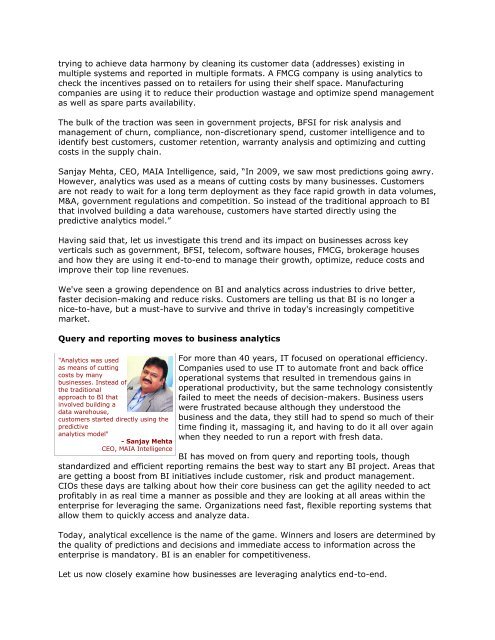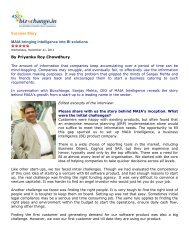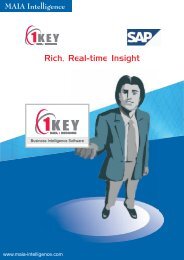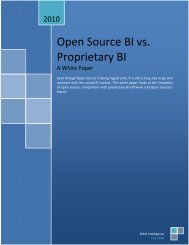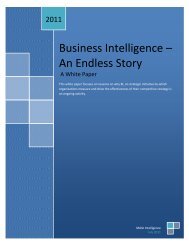Identifying cost culprits and optimizing business using analytics
Identifying cost culprits and optimizing business ... - MAIA Intelligence
Identifying cost culprits and optimizing business ... - MAIA Intelligence
Create successful ePaper yourself
Turn your PDF publications into a flip-book with our unique Google optimized e-Paper software.
trying to achieve data harmony by cleaning its customer data (addresses) existing in<br />
multiple systems <strong>and</strong> reported in multiple formats. A FMCG company is <strong>using</strong> <strong>analytics</strong> to<br />
check the incentives passed on to retailers for <strong>using</strong> their shelf space. Manufacturing<br />
companies are <strong>using</strong> it to reduce their production wastage <strong>and</strong> optimize spend management<br />
as well as spare parts availability.<br />
The bulk of the traction was seen in government projects, BFSI for risk analysis <strong>and</strong><br />
management of churn, compliance, non-discretionary spend, customer intelligence <strong>and</strong> to<br />
identify best customers, customer retention, warranty analysis <strong>and</strong> <strong>optimizing</strong> <strong>and</strong> cutting<br />
<strong>cost</strong>s in the supply chain.<br />
Sanjay Mehta, CEO, MAIA Intelligence, said, “In 2009, we saw most predictions going awry.<br />
However, <strong>analytics</strong> was used as a means of cutting <strong>cost</strong>s by many <strong>business</strong>es. Customers<br />
are not ready to wait for a long term deployment as they face rapid growth in data volumes,<br />
M&A, government regulations <strong>and</strong> competition. So instead of the traditional approach to BI<br />
that involved building a data warehouse, customers have started directly <strong>using</strong> the<br />
predictive <strong>analytics</strong> model.”<br />
Having said that, let us investigate this trend <strong>and</strong> its impact on <strong>business</strong>es across key<br />
verticals such as government, BFSI, telecom, software houses, FMCG, brokerage houses<br />
<strong>and</strong> how they are <strong>using</strong> it end-to-end to manage their growth, optimize, reduce <strong>cost</strong>s <strong>and</strong><br />
improve their top line revenues.<br />
We've seen a growing dependence on BI <strong>and</strong> <strong>analytics</strong> across industries to drive better,<br />
faster decision-making <strong>and</strong> reduce risks. Customers are telling us that BI is no longer a<br />
nice-to-have, but a must-have to survive <strong>and</strong> thrive in today's increasingly competitive<br />
market.<br />
Query <strong>and</strong> reporting moves to <strong>business</strong> <strong>analytics</strong><br />
"Analytics was used<br />
as means of cutting<br />
<strong>cost</strong>s by many<br />
<strong>business</strong>es. Instead of<br />
the traditional<br />
approach to BI that<br />
involved building a<br />
data warehouse,<br />
customers started directly <strong>using</strong> the<br />
predictive<br />
<strong>analytics</strong> model"<br />
- Sanjay Mehta<br />
CEO, MAIA Intelligence<br />
For more than 40 years, IT focused on operational efficiency.<br />
Companies used to use IT to automate front <strong>and</strong> back office<br />
operational systems that resulted in tremendous gains in<br />
operational productivity, but the same technology consistently<br />
failed to meet the needs of decision-makers. Business users<br />
were frustrated because although they understood the<br />
<strong>business</strong> <strong>and</strong> the data, they still had to spend so much of their<br />
time finding it, massaging it, <strong>and</strong> having to do it all over again<br />
when they needed to run a report with fresh data.<br />
BI has moved on from query <strong>and</strong> reporting tools, though<br />
st<strong>and</strong>ardized <strong>and</strong> efficient reporting remains the best way to start any BI project. Areas that<br />
are getting a boost from BI initiatives include customer, risk <strong>and</strong> product management.<br />
CIOs these days are talking about how their core <strong>business</strong> can get the agility needed to act<br />
profitably in as real time a manner as possible <strong>and</strong> they are looking at all areas within the<br />
enterprise for leveraging the same. Organizations need fast, flexible reporting systems that<br />
allow them to quickly access <strong>and</strong> analyze data.<br />
Today, analytical excellence is the name of the game. Winners <strong>and</strong> losers are determined by<br />
the quality of predictions <strong>and</strong> decisions <strong>and</strong> immediate access to information across the<br />
enterprise is m<strong>and</strong>atory. BI is an enabler for competitiveness.<br />
Let us now closely examine how <strong>business</strong>es are leveraging <strong>analytics</strong> end-to-end.


